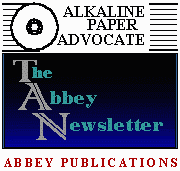
Abbey Publications
Selections from North American Permanent Papers
Ellen McCrady <abbeypub@flash.net>
1998

Abbey Publications
Selections from North
American Permanent Papers
Ellen McCrady <abbeypub@flash.net>
1998
The Image Permanence Institute's address is: Rochester Institute of Technology, 70 Lomb Memorial Dr., Rochester, NY 14623-5604 (Fax 716/475-7230).
The previous sections of this publication have been concerned with the permanence of the paper itself and its life expectancy as an archival material. This section covers a different aspect of paper stability, specifically the effect of paper and paper products on the permanence of materials with which they are in contact. This is particularly important in the permanence behavior of photographic silver images.
Photographic sheet films, such as x-rays or portraits, are stored in paper envelopes. This is also true for photographic plates. Microfilms in roll form have been kept in cardboard boxes while photographic paper prints are mounted on paper mats or on paper pages in albums. In all these applications there have been numerous examples where the paper enclosure caused unwanted and deleterious changes in the appearance of the silver image. These changes can take several forms. In some cases the silver image has turned brown and faded. In other materials, particularly photographic paper prints, a silver reflecting mirror appeared on the print surface, with a resulting deterioration of the print appearance. Image degradation in microfilms was manifested by the appearance of small red spots which could affect legibility. These spots are well known in the industry as redox blemishes and were particularly prevalent when microfilm was stored in cardboard boxes.
While these photographic defects appear quite different, they are all caused by essentially the same chemical reaction. The enclosure paper, album or mat material releases oxidizing gases which react with the silver image. The silver oxidizes, causing it to be invisible, and more important, it becomes mobile and can literally move to another location in the photographic layer. This oxidized silver can then be reduced forming visible metallic silver again but this time it is in an unwanted area such as in redox blemishes or as a mirror on the surface of the image layer.
Consequently a very important property for an enclosure material is whether it will release oxidizing gases over time. This is a difficult property to determine since it is a predictive characteristic which can only be evaluated by an accelerated test. Such a test was developed after many years of research by the Image Permanence Institute in Rochester, NY. This Photographic Activity Test (PAT) involves incubating the enclosure material at elevated temperature and humidity in close contact with several sensitive detectors. Oxidizing gases that are released react with these detectors and the resulting changes can be measured. These measured changes are the degree of fading and appearance of mottle in a silver detector and the degree of stain growth in a non-image detector. Materials pass this test when the changes are less than the limits arrived at from practical experience. This PAT test has been accepted both as a national (ANSI/APM IT 9.16-1993) and as an international standard (ISO 10214-1991). The test can be performed by several testing laboratories experienced in this field as well as in a number of government laboratories.
Specifications for papers used for photographic enclosures are given in ANSI IT 9.2-1991. They must meet the limits of the PAT but also have the same criteria for alkali reserve for black-and-white images as specified in ANSI/NISO Z39.48-1992. The pH requirements differ from Z39.48, being between 7.2 and 9.5 for black-and-white images and between 7.0 and 7.5 for color.
Papers that meet the PAT test specifications are identified as such in the catalogs of three companies that distribute archival enclosure materials: Gaylord (800/448-6160), University Products (800/628-1912), and Light Impressions (800/828-6216).